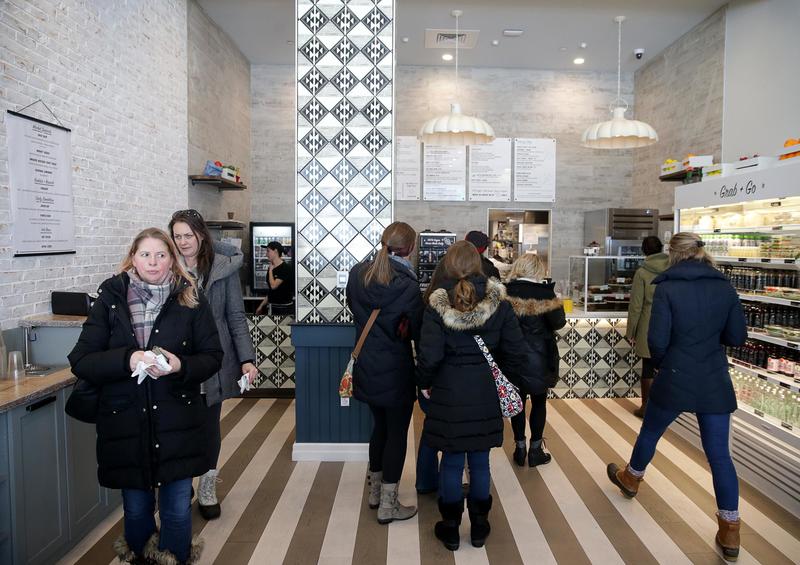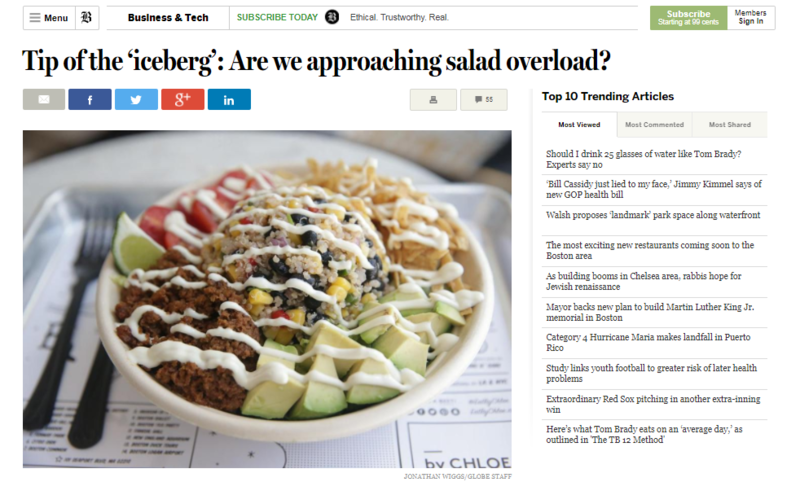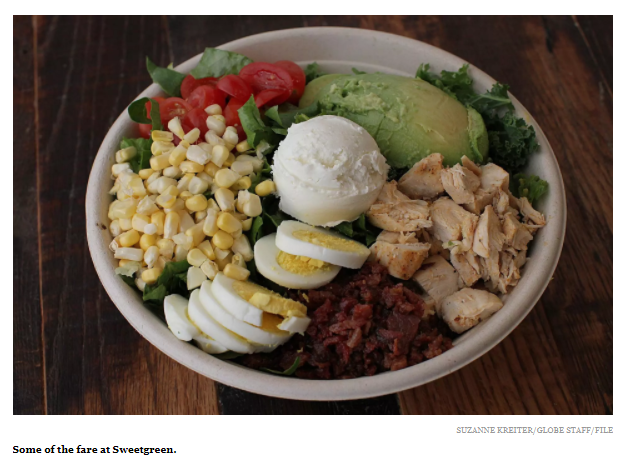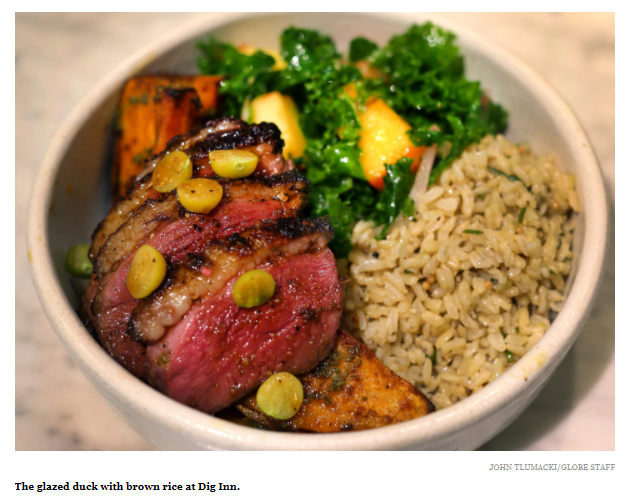Tip of the ‘iceberg’: Are we approaching salad overload?
Here’s a short list of things you can do as you wait in line during the lunch rush at By Chloe, the new vegan restaurant in the Seaport (and yes, there will be a line):
Play a game and give yourself one point for each person wearing leggings, SoulCycle gear, or a Canada Goose jacket — double points if they’re wearing all three. Admire the restaurant’s design and wonder if you can find that same tile pattern for your kitchen. And, as you get your kale caesar bowl and settle in to eat, try to shake off the creeping feeling of deja vu.
Perhaps you and your waistline have noticed, but it’s now easier than ever to find healthy lunch options in Boston.
The concept is called fast-casual, and more than two dozen of these places have been launched in recent months in and around Boston, each offering stylish, quick meal service, and locally sourced variations on a theme. (Think grain + protein + kale served in a bowl at about a $10 price point.) Wander along Boylston Street, and it can seem a bit like salad row.
That uptick comes even after overall restaurant growth flattened in Greater Boston last year. It’s a lucrative enough trend that it has lured some of the city’s high-end restaurateurs into the lunch game, from Jody Adams serving upscale gyros at her two Saloniki locations to Roger Berkowitz’s plan to launch Legal Fish Bowl in Kendall Square.
For restaurant owners, creating a high-traffic, healthy-lunch business can be cost-effective. The math works because it requires fewer staffers and costs less to build out these smaller retail spaces, while price margins are often higher, because sourcing grains and leafy greens costs far less than obtaining expensive proteins.

The afternoon crowd at By Chloe. JONATHAN WIGGS/GLOBE STAFF
Berkowitz said a fast-casual lunch business is a way to expand his reach without doing the heavy lifting of launching a full-service restaurant.
“If you’re going to open a restaurant today, you don’t want to have a huge infrastructure” investment, he said. “The kids — the millennials — really want a more informal, faster setting.”
And it’s not just lunch.
“People have started to change their habits in terms of how they eat. Instead of having a sit-down meal, they might opt for that $10 salad to bring home or meet someone there for dinner,” said David Downing, director of leasing and development at the real estate advisory firm Graffito SP.
Chipotle is widely credited with having started the fast-casual movement, serving quick, made-to-order food using high-quality ingredients in a far more stylized setting than your average McDonald’s. And while Chipotle’s business has struggled following food-borne illness outbreaks, it has given way to a host of imitators that have realized even healthier fare was the next frontier.
It helps, of course, that a successful fast-casual concept is easy to replicate.
A slew of likeminded national chains, including SweetGreen, Dig Inn, Verts, and By Chloe, have set up shop here and have multiple locations scheduled to open. Most have little trouble drawing customers willing to spend their entire lunch hour waiting in line for a meal.
And with traditional retail stores being shuttered in some areas, chefs are seeing an opportunity to fit into spaces that might have been off-limits in the past, said Matt Camilleri of the RealFood consulting group — particularly if serving grain bowls doesn’t require spending $30,000 to install a ventilation system for a full kitchen.
Sam Wasser, cofounder and creative director of By Chloe, the vegan chain run by the same group as New York’s BLT Steak and BLT Prime, said a casual concept is more in line with what younger, urban diners want.
“What we’ve seen with our customers — and millennials in general — is they are not really interested in paying extra to be waited on,” Wasser said.
Boston chef Jody Adams said the push into fast- or “fine-”casual dining, as many are beginning to call it, reflects the democratization happening in the industry.
When she started cooking, the best chefs deigned themselves worthy only of white-tablecloth establishments. But the bistro movement in the 1980s and ’90s pushed better food downstream. Now we’re seeing that happen with quick service.
Even so, she said, she balked when her team first approached her with the idea of opening a fast-casual place.
“My response was ‘What, a sandwich shop? Me, Jody Adams?’ ” she joked. But after seeing the success of Danny Meyer and Shake Shack, she decided to “get over it and have fun.”
All that fear of missing out might not be as sustainable as the veggies in those bowls, however. Nationally, the growth of fast-casual restaurants is showing signs of slowing, having slipped in 2016 after several years of sustained growth, according to Bonnie Riggs, a restaurant analyst at NPD Group. The market, she said, is becoming increasingly crowded.
Which means acknowledging a hard truth: Boston may be approaching peak salad.
That has made more-established players, like b.good’s Jon Olinto, feel a bit weary. For years, Olinto promoted his chain of healthy fast-food restaurants by having b.good employees sport hamburger costumes and run in the Boston Marathon. Then a burger boom hit the city.
“Six or seven years ago, there was this incredible rush to serve better burgers, based on the success of Five Guys and Shake Shack,” he said. Now, after 15 years in business, kale and grain bowls are his number one menu category. So last month he invested in two new costumes: a green smoothie suit, and a kale and grain bowl ensemble.
As he struggles to stand out, he worries. “We really can only support so many salads,” he said.
For a time, the national numbers bore that out. “Fast-casual had been growing at 7, 8, 9 percent year after year. It’s been considered the darling of the industry,” said Riggs, the food industry analyst. But last year, the numbers took a hit for the first time. Chains are beginning to struggle to keep up that growth, she said. “That space has gotten too crowded.”
Riggs said fast-casual concepts tend to do better in cities, thanks to their density and deeper-pocketed clientele. But nationally, lunch traffic was down 2 percent in the United States last year, she said, meaning that the endless influx of new lunch options can’t last forever. “Major metropolitan areas tend to be more affluent,” she said. “But if we keep seeing the trend we’re seeing, I’d suggest that eventually will slow.”
Olinto agreed. “The way to differentiate becomes really difficult for competitors. You can be innovative and creative, but, at the end, if you’re a salad concept, it’s going to be tough to compete with five others next door.”
That’s where a kale costume can come in handy.
Mentions
Securities Disclaimer
This website is for informational purposes only and does not constitute an offer or solicitation to sell shares or securities. Any such offer or solicitation will be made only by means of an investment's confidential Offering Memorandum and in accordance with the terms of all applicable securities and other laws. This website does not constitute or form part of, and should not be construed as, any offer for sale or subscription of, or any invitation to offer to buy or subscribe for, any securities, nor should it or any part of it form the basis of, or be relied on in any connection with, any contract or commitment whatsoever. EB5Projects.com LLC and its affiliates expressly disclaim any and all responsibility for any direct or consequential loss or damage of any kind whatsoever arising directly or indirectly from: (i) reliance on any information contained in the website, (ii) any error, omission or inaccuracy in any such information or (iii) any action resulting therefrom.







